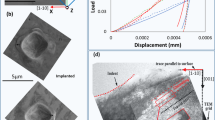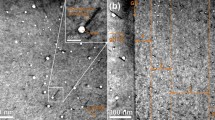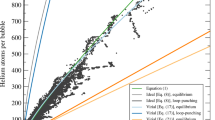Abstract
The microstructural changes occurring in metals during ion bombardment with helium or hydrogen isotopes have important implications in several areas of technology1 such as in the deterioration of the accelerator targets suggested for use as intense neutron sources in cancer therapy2; and in the plasmawall interactions which could strongly influence the operation of future thermonuclear fusion reactors (see ref. 3). Research has shown that helium ion irradiation of Mo4,5, Cu, Ni and stainless steel1 to high doses can result in a superlattice of small (∼2 nm diameter) helium bubbles in very high concentration (∼1025 m−3) even at temperatures up to 0.35 Tm (refs 1,4). The mechanisms involved in the bubble growth6 and in the superlattice formation have been discussed but the role of displacement damage collisions on bubble growth has received little study. In the present work, specimens containing a superlattice of helium bubbles formed during prior helium ion irradiation have been irradiated with 1 MeV electrons to create a specific collision regime. This was found to induce bubble growth and changes in superlattice parameters, in both copper and nickel.
This is a preview of subscription content, access via your institution
Access options
Subscribe to this journal
Receive 51 print issues and online access
$199.00 per year
only $3.90 per issue
Buy this article
- Purchase on Springer Link
- Instant access to full article PDF
Prices may be subject to local taxes which are calculated during checkout
Similar content being viewed by others
References
Johnson, P. B. & Mazey, D. J. Nature 276, 595–596 (1978); Harwell Report AERE R-9290, 1–14 (1978).
Wynchank, S. & Jones, D. T. L. S. Afr. Med. J. 50, 653–657 (1976).
Bauer, W. J. nucl. Mater. 76 & 77, 3–15 (1978).
Mazey, D. J., Eyre, B. L., Evans, J. H., Erents, S. K. & McCracken, G. M. J. nucl. Mater. 64, 145–156 (1977).
Sass, S. L. & Eyre, B. L. Phil. Mag. 27, 1447–1453 (1973).
Evans, J. H. J. nucl. Mater. 76 & 77, 228–234 (1978); J. nucl. Mater. 79, 249–251 (1979).
Baskes, M. I. & Wilson, W. D. J. nucl. Mater. 63, 126–131 (1976); Rad. Eff. 37, 93–98 (1978).
Nelson, R. S. Harwell Rep. AERE R-9380, 1–7 (1979).
Author information
Authors and Affiliations
Rights and permissions
About this article
Cite this article
Johnson, P., Mazey, D. Helium gas-bubble superlattice in copper and nickel. Nature 281, 359–360 (1979). https://doi.org/10.1038/281359a0
Received:
Accepted:
Published:
Issue Date:
DOI: https://doi.org/10.1038/281359a0
This article is cited by
-
Localized Helium Implantation in SiCf/SiCm Composites Comparing Fiber and Matrix Swelling
JOM (2020)
-
Irradiation-Dependent Helium Gas Bubble Superlattice in Tungsten
Scientific Reports (2019)
-
Engineering self-organising helium bubble lattices in tungsten
Scientific Reports (2017)
-
Interface-Induced Ordering of Gas Molecules Confined in a Small Space
Scientific Reports (2014)
Comments
By submitting a comment you agree to abide by our Terms and Community Guidelines. If you find something abusive or that does not comply with our terms or guidelines please flag it as inappropriate.



